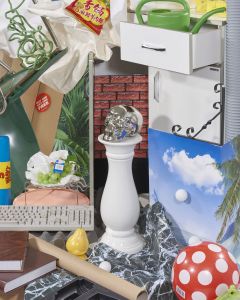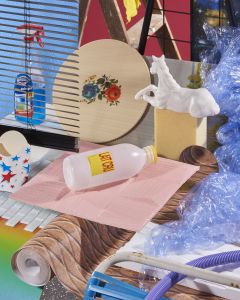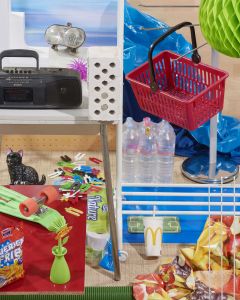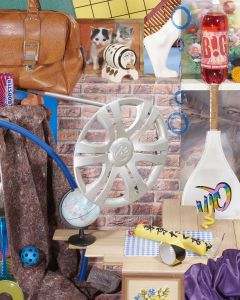IN THIS series of photographs of intricately arranged, arbitrary goods, we are confronted with our materialistic daily life. It’s a common experience to feel suffocated by too many things that are just waste in transit, the rubbish of tomorrow.
Our economic model is reliant on this treadmill of production that ensures its own survival. The photos are a reminder of the waste and accumulation found on platforms like Alibaba and eBay, providing us with things that mostly are devoid of any emotional value and completely disconnected from basic human needs.
The pictures are so busy – planes overlap, objects intersect – they seem designed to become lost in. Like e-commerce recommendations ‘you may also like’, and ‘friends recommend’, and ‘often bought together’, they don’t seem to tell a story but point the way to tantalizing, possible futures.
Whereas we already live in a world that feels like an illusion, obscured by layers of consumerism, a life in which the line between information, entertainment, and promotion of products gets increasingly blurred.
KUVASARJA huolellisesti järjestetyistä satunnaisista esineistä tuo katsojan eteen materialistisen arkemme. Monesti koemme hukkuvamme tavaravirtaan, joka on vain läpikulkumatkalla päätyäkseen huomisen jätteeksi.
Talousmallimme perustuu itseään ylläpitävään tuotannon oravanpyörään. Nämä kuvat muistuttavat jätekertymästä Alibaban ja eBayn kaltaisilla kauppapaikoilla, joiden tarjonta koostuu lähinnä emotionaalisesti tyhjistä tavaroista vailla yhteyttä inhimillisiin perustarpeisiin.
Päällekkäisine tasoineen ja tavaroineen nämä sekavat kuvat ovat kuin luotuja katsojan eksyttämiseen. Kuten verkkokauppojen suosittelut – ‘Saatat pitää myös…’, ‘Kaverisi suosittelevat…’ tai ‘Muut ostivat lisäksi…’ – ne eivät kerro tarinaa vaan ohjaavat aina vain uusien houkutusten pariin.
Elämme sekavassa, päällekkäisten kulutustasojen illuusiomaailmassa, jossa rajat informaation, viihteen ja markkinoinnin välillä hämärtyvät päivä päivältä enemmän.





